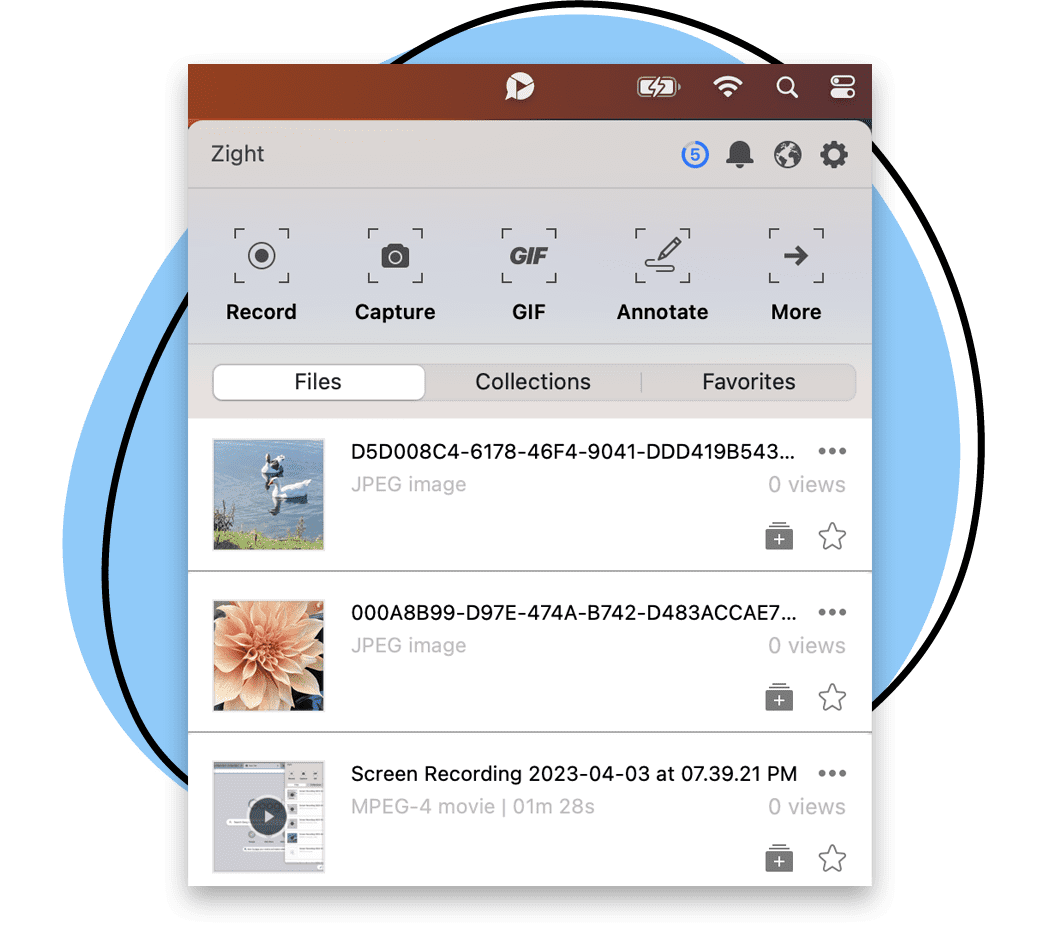In today’s dynamic world, those who grasp the art of crafting captivating visual content and unleashing its full potential hold the key to unparalleled success. And guess what? You’re one of them since you’re here with us.
From untapped opportunities to proven techniques, this is your ticket to mastering the art of video marketing like never before. So, fasten your seatbelts and prepare to transform how you connect with your audience. In this article, we’ll help you get started with online video marketing and teach you how to create awesome video content for your company. Let’s make your brand shine!
Before we get to that, are you looking for a video marketing tool to help you record your screen, take screenshots, record webinars, make customer support step-by-step GIFs and more for faster communication? Sign up with Zight for free today!
What is Online Video Marketing?
Let’s go back to the beginning — this is a beginner’s guide, after all — and start with the definition of online video marketing. According to HubSpot, online video marketing is:
“Using videos to promote and market your product or service, increase engagement on your digital and social channels, educate your consumers and customers, and reach your audience with a new medium.”
The kind of marketing video you create doesn’t matter, just as long as the content works to promote your company and its products in some way. So live broadcasts, vlogs, YouTube video ads, and product demo videos all fit under the “online video marketing” umbrella.
The Importance of Online Video Marketing
When it comes to marketing, we’re always trying to predict the future. Which social media network is poised to take off in the next year, and which ones will start to fade into the background? (Hint: Facebook videos are killing it according to our video marketing stats) Is there a new video ads platform we must be aware of? And will email still be the best way to connect with our customers in the coming months?
While we obviously can’t know everything that the future holds, we can be sure that the importance of online video marketing will only continue to rise. This is because online video presents businesses with three distinct benefits:
1. Better SEO
One of the main goals of content marketing is to draw awareness to a company and its products. What better way to do this than by claiming the top spot in Google search results whenever your chosen keyword is queried?
Online video marketing boosts SEO, partly because it increases dwell time on web pages, AKA the amount of time a web user spends (or dwells) on a website.
Research from Mist Media tells us that users spend 88% more time on websites that contain videos. That’s a massive improvement!
But that’s not all: websites that utilize online video marketing are also 53 times more likely to rank on the first page of Google than sites that don’t. If it’s not enough to get you on the online video marketing bandwagon, we don’t know what it will be.
2. Higher Engagement
Online video marketing can also result in higher engagement levels. Our society is very visual. We like to see things, not just read or hear about them — so much so that audiences, on average, are 10 times more likely to comment on and share video content than they are to take similar action on blogs or standard social media posts.
If you want to engage your target audience on a deeper level, you need to start creating video content for them to consume.
3. More Conversions
Lastly, online video marketing (when done correctly) almost always leads to higher conversion rates. This makes sense, given what we’ve just learned about the benefits of video about SEO and engagement.
If your audience can find your marketing videos easier because they show up on the first page of Google results and engages with them much more frequently. Once they have the chance to watch, better conversions are only to be expected. What you might not realize, though, is how much better…
According to Deposit Photos, conversions rise by as much as 80% when a landing page contains a video. And email open rates can jump up a whopping 19% by including the word “video” in the subject line.
8 Types of Online Marketing Videos You Can Create For Your Business
Different types of online marketing videos can be created for your business. Understanding these online marketing videos empowers marketers to choose the right business approach, considering the target audience, goals, and available resources. Let’s explore each type in detail:
1. Demo Videos

Demo videos are marketing videos showcasing your product or service in action, demonstrating its features, benefits, and functionality. They aim to give potential customers a firsthand experience of what your offering can do.
Demo videos are highly visual and often combine screen recordings, product shots, and narration or voice-over to guide viewers through the demonstration. They highlight key features, illustrate how the product solves a problem, and emphasize its value. Therefore, these marketing videos can be highly effective in convincing viewers of the value and usability of your product, leading to increased conversions.
Benefits
- They capture viewers’ attention and generate their interest in your product.
- Visual representation helps viewers understand how the product works and its value proposition.
- By showcasing the product’s benefits, demo videos can increase conversion rates.
- Address potential customers’ common questions or concerns.
- Optimizing demo videos with relevant keywords can enhance search engine visibility.
Potential Challenges
- Demo videos can sometimes become too lengthy, risking viewer disengagement if they are not concise and focused.
- Also, creating high-quality demo videos may require the best video software or equipment in the market, which can be challenging for some businesses.
- These marketing videos may not address specific customer needs or use cases, potentially leading to less relevance for certain viewers.
2. Event Videos
Event videos capture the atmosphere, highlights, and key moments of a specific event related to your business, such as conferences, trade shows, or product launches. These marketing videos aim to give viewers a sense of the event’s energy and give them valuable insights. Also, they showcase the energy, excitement, and engagement surrounding the event.
Event videos are typically a compilation of footage captured during the event, including keynote speeches, product demonstrations, interviews, and attendee interactions. They are often combined with background music, narration, or commentary to enhance storytelling.
Benefits
- They create excitement, generate buzz, and engage viewers.
- Sharing event videos on social media platforms can expand brand visibility.
- Event videos featuring industry experts or guest speakers position your brand as knowledgeable and authoritative.
- They can include testimonials from attendees, providing social proof of your brand’s value.
Potential Challenges
- They must be created and released promptly after the event, requiring efficient production and editing.
- Due to varying lighting, sound conditions, and camera stability, it may feature quality footage during live events.
- The impact of event videos is tied to the success and appeal of the event itself. The video may be less impactful if the event doesn’t meet expectations.
3. Interview Videos

Interview videos feature industry experts, satisfied customers, or other relevant individuals who provide insights, opinions, or testimonials about your brand. These marketing videos aim to leverage the expertise and credibility of the interviewees to build trust and establish your brand as a thought leader.
Interview videos can be conducted in a question-and-answer format, in conversation style, or as monologues. They typically involve carefully prepared questions and can cover various topics, from industry trends to product reviews.
These videos can even be streamed through a live transcoder to further increase engagement and answer questions in real-time.
Benefits
- Interview videos enhance your brand’s reputation by featuring knowledgeable individuals.
- Real people sharing their experiences or expertise can build trust with the audience.
- Interviews can create compelling narratives that resonate with viewers.
- Customer testimonials in interview videos serve as powerful social proof.
Potential Challenges
- Scheduling interviews with industry experts or relevant individuals can be challenging
- Interviewees’ responses may not always align perfectly with the messaging or narrative you had in mind.
- Poorly conducted or uninteresting interviews may result in unengaging video content.
4. How-to and Educational Videos
How-to and educational videos provide instructional content and valuable information to viewers, guiding them on specific tasks or educating them on relevant topics. These marketing videos aim to position your brand as an expert and provide value to your target audience.
This marketing video has a step-by-step format, clearly explaining concepts and processes or providing practical guidance. They can include visual demonstrations, on-screen annotations, graphics, and narration to facilitate understanding.
Benefits
- They position your brand as an expert in your industry.
- Providing solutions to common challenges or answering FAQs can attract and engage your target audience.
- Educational videos offer valuable content to increase brand visibility and awareness.
- Informative videos are highly shareable, extending your brand’s reach.
Potential Challenges
- The internet is saturated with how-to and educational videos, making it crucial to create content that stands out and offers unique value.
- Industries and technologies evolve, requiring regular updates to ensure the accuracy and relevance of how-to videos.
- Striking the right balance between providing enough information and keeping the content easily digestible can be challenging.
5. Explainer Videos

Explainer videos simplify complex concepts, processes, or ideas into easily understandable visuals and storytelling. They aim to provide viewers with a clear understanding of your product, service, or message.
These marketing videos often utilize animations, graphics, narration, and concise scripts to convey information effectively. They break down the topic into engaging visuals and narration, presenting it concisely and compellingly.
Benefits
- They help viewers grasp complex information quickly and easily.
- Visuals and narratives in explainer videos captivate and entertain viewers.
- The visual explanations enhance viewer understanding and memory retention.
- These videos can be used across various platforms, including websites, social media, and presentations.
Potential Challenges
- They may not have sufficient time or depth to explain highly complex or technical subjects.
- A high-quality animated video can be costly, especially if it requires professional animators or specialized software.
- Ensuring the message is clear and understandable can be challenging for explainer videos.
6. Animated Videos / GIFs
Animated videos and GIFs use illustrations, graphics, or animations to convey messages, tell stories, or demonstrate concepts. They add a visually appealing and dynamic element to your marketing strategy.
Animated marketing videos leverage creativity and flexibility to represent ideas and engage viewers visually. They can simplify complex concepts, create entertaining narratives, or deliver impactful messages.
Benefits
- Allows for imaginative storytelling and visual representation of ideas.
- Attract attention and stand out in crowded online spaces.
- Complex concepts can be simplified and made more engaging through animations.
- Animated videos and GIFs have high shareability, increasing brand exposure.
Potential Challenges
- Time-consuming
- Overly complex animations or excessive visual effects may distract viewers from the core message.
7. Customer Testimonial Videos
Customer testimonial videos feature satisfied customers sharing their positive experiences and feedback about your product or service. These marketing videos aim to build trust, showcase real-life experiences, and influence potential buyers.
Customer testimonial videos typically include customer interviews or statements highlighting personal stories, benefits derived from your product or service, and overall satisfaction.
Benefits
- They build trust and credibility by showcasing real customer satisfaction.
- Hearing customers’ genuine experiences and emotions can resonate with potential buyers.
- Positive testimonials have a significant impact on influencing purchasing decisions.
- Involving customers in testimonial videos fosters a sense of loyalty and strengthens relationships.
Potential Challenges
- Viewers may question the authenticity of customer testimonials, especially if they appear scripted or insincere.
- They may primarily feature positive feedback, lacking a balanced representation of customer experiences.
- Convincing customers to participate in testimonial videos can be challenging, limiting content availability.
8. Case Study Videos
Case study videos showcase real-life examples of how your product or service helped a customer overcome challenges or succeed. They provide detailed insights into the benefits and outcomes of using your offering.
These marketing videos typically involve client interviews, presenting their challenges, solutions implemented, and the positive outcomes they achieved. They highlight the value and effectiveness of your product or service.
Benefits
- Provide evidence of your product’s effectiveness or the value of your services.
- Present a comprehensive narrative that resonates with viewers.
- Offer insights into your target audience’s pain points and demonstrate your problem-solving capabilities.
- Transparently showcasing successful client collaborations builds trust and credibility.
Potential Challenges
- Some clients may not allow sharing specific details or metrics in the case of study videos, limiting the information you can provide.
- Gathering data, conducting interviews, and creating compelling case study videos can be time-intensive.
- Case study videos may not resonate with all viewers if they do not align with their specific industry, needs, or challenges.
6 Tips to Create an Online Video Marketing Strategy that Works
Online video marketing is beneficial and will continue for the foreseeable future. Which begs the question, “How can we capitalize on this content form and grow our businesses quickly and consistently?” That’s what we’ll cover in this section.
1. Know Your Online Video Marketing Goals
Successful online video marketing always starts with a strong understanding of the goals one’s trying to accomplish. If you don’t know why you’re creating video content, your efforts will flounder, and you won’t be able to make a measurable impact on your company.
So what will it be? Are you hoping to drive traffic, boost email signups, or increase revenue? All of these goals are attainable with online video marketing.
We suggest setting SMART goals. If you’re unfamiliar with the concept, SMART is an acronym for Specific, Measurable, Achievable, Relevant, and Time-Bound.

SMART goals explained:
- Specific: The best goals are extremely specific. What exactly are you trying to achieve, and by when? The more specific you can be, the better your chance of accomplishing your goals.
- Measurable: Your goals should also be measurable. That way, you’ll know when you’ve met your objectives and can assess your progress. So decide which metrics you’ll use to measure your online video marketing efforts and analyze them.
- Achievable: We applaud the ambition, but unattainable goals don’t benefit anyone. They might sow seeds of discouragement and harm your company. Before deciding on a specific objective, ensure it’s achievable and that you’re willing to make the necessary sacrifices.
- Relevant: Every online video marketing goal you commit to should be relevant to your business. You might not, for example, want to spend time creating video ads aimed at teenage girls if you’re still trying to build up a customer base of grown women.
- Time-Bound: Finally, every goal you set should be time-bound, which means it should have a deadline. Otherwise, you risk “pushing off” your goals and never actually accomplishing them. At the same time, make sure your time frames are realistic, or you’ll quickly become discouraged when you miss your target.
Create SMART goals for your online video marketing efforts, and you’ll be much more likely to achieve them and move your company forward.
2. Understand Your Target Audience
Understanding your target audience is the most important thing after understanding your online video marketing goals. Think about it: if you don’t know who you’re trying to reach with your marketing videos, you’ll have difficulty creating connected content.
Fortunately, discovering who your target audience is, if you aren’t yet sure, isn’t that difficult. You need to invest the time. Analyze your internal company metrics to learn about your current customers. Then take to the internet and dig deeper into this specific subset of people.
You’ll want to discover your audience’s demographic information, like age, gender, occupation, and income level, and psychographic details, like their hopes, fears, and daily challenges. Once you’ve learned this information, assemble it into a customer persona so that you can use it to create marketing videos.
3. Decide What Kind of Online Video You’ll Produce
Once you know the goals you want to accomplish with your online videos and the target audience you hope to reach, you can determine what kind of video content will work best. Would your company and its ideal viewers be better served through product demo-type content or animated brand videos? What about an explainer video or an interview with an expert?
To help you determine the right video content format, think about the story you want to tell and where your marketing video fits in the buyer’s journey.
For example, if you want to share a marketing video that explains your company’s mission and brand values, you might decide that your brand’s story is best told with animation and aimed at folks in the early stages of the buyer’s journey. You might create a marketing video like the famous Chipotle video that hit the internet in 2012.
We should also mention that your goals and audience might shift as you begin publishing video content. If this happens, also change the kinds of marketing videos you create.
4. Write a Compelling Video Script
When your online video marketing goals, audience, and video types are locked down, you can begin the creation process, which should almost always start with scripting. Even live videos should have some framework before the record button is pressed.
Your script can be as lax or detailed as you want. Some creators just put together a rough outline and deliver their content in a loose, off-the-cuff kind of way. Others prefer to write out every word they’ll say on camera.
The key is to script something so that you have an idea of what your marketing video is about and the kind of content you’ll be sharing. This will save you much time during editing and help you create professional marketing videos.
5. Use the Right Video Marketing Tools
Online video marketing is much easier and more enjoyable when using the right tools. Here are a few video software programs that we recommend investing in:
a). iMovie
iMovie is a popular video editing software that almost every Mac user is familiar with. It’s easy to learn and lets users quickly edit the footage they’ve already captured on their phones or video cameras. Moreover, users also get access to eye-catching titles, image filters, basic effects, and the ability to edit 4K video clips. The best part? It’s free!
Unfortunately, iMovie can only be accessed on Apple devices. But if you’re already part of the Mac faithful, this program is great as an online marketing video maker.
b). Biteable
Biteable makes it easy to create professional marketing videos in no time flat. That’s why mega-corporations like Microsoft, Panasonic, and IBM use it. Users can access a large (growing) library of customizable templates and royalty-free media files like images, video clips, animated characters, and background music.
The Biteable interface is intuitive and can be accessed for a low price of $0 a month. Though, if you want access to upgraded features, you must pay a monthly fee. For those just dipping their toes in video editing, Biteable is an excellent option for creating marketing videos.
c). Zight (formerly CloudApp)
We’ve talked about a couple of video editing tools so far. But what about a tool to help you create your online video marketing footage? For that, we recommend Zight. Our software’s screen recorder, webcam recorder, GIF creator, and image annotator will allow you to easily create tutorials, product demo videos, vlogs, and other video clips.
And just like iMovie and Biteable, Zight can be used for free too. Sign up for your free account today and see why well-known brands like Uber, Adobe, and Salesforce are loyal customers.
6. Analyze and Optimize Your Online Video Marketing Efforts
After publishing your video content in any digital location, you must analyze its results. Are audiences connecting with it? Is it helping your brand accomplish the goals you set? What can you do better next time so that your online video marketing efforts see more success?
Don’t get too wrapped up in vanity metrics like the number of views unless your main objective is brand awareness or something similar. Just because a video only gets watched 72 times doesn’t necessarily mean it’s a failure.
Refer back to your SMART goals and the metrics you chose to measure for each. This is your north star. 72 views is a smashing success if it leads to 10 purchases and your company achieves the goal of a higher conversion rate.
Step-by-Step Guide for Making Any Online Marketing Video using Zight
This step-by-step guide will take you through the seamless process of making any online marketing video using Zight.
Step 1: Download and Install Zight

Begin your journey to creating captivating online marketing videos by downloading and installing Zight, the ultimate video marketing tool.
1. Visit the Zight website and click on the download button to get started.
Follow the simple installation instructions to quickly run Zight on your device.
2. Familiarize Yourself with Zight’s Features
- Launch Zight and take a moment to explore its user-friendly interface and powerful features.
- Discover the intuitive controls that will empower you to craft visually stunning and attention-grabbing marketing videos.
3. Choose Your Video Style
- Before diving into the creative process, decide on the style of your marketing video. Zight offers many marketing video templates and customization options to suit your brand and message.
- From animated characters to professional templates, Zight has everything you need to make your video stand out.
4. Record Your Video or Screen
- Zight empowers you to create compelling marketing videos by recording your screen or utilizing your device’s camera.
- If you’re demonstrating a product or showcasing a service, easily record your screen to capture every detail flawlessly.
- Alternatively, if you prefer a personal touch, record yourself speaking directly to your audience using your device’s camera.
5. Add Engaging Visuals and Effects
- Enhance your marketing video with Zight’s array of captivating visuals and effects.
- Spice up your video with stunning animations, text overlays, and eye-catching transitions to keep your viewers glued to the screen.
- Furthermore, utilize Zight’s library of images, video clips, and GIFs to add that extra punch of creativity and professionalism.
6. Customize and Brand Your Video
- Make your marketing video your own by customizing it with your brand elements.
- Add your logo, choose your brand colors, and select the perfect fonts to maintain consistency and reinforce your brand identity.
- Zight’s easy-to-use customization options ensure your video aligns seamlessly with your video marketing strategy.
7. Export and Share

- Once you’re satisfied with your masterpiece, it’s time to export and share your marketing video with the world.
- Zight provides various export options, allowing you to save your video in the desired format and resolution.
- Share your video across social media platforms, embed it on your website, or include it in your email marketing campaigns to captivate your audience and drive engagement.
How to Upload and Share Your Online Marketing Video Fast
In the fast-paced world of online video marketing, marketers must upload and share their videos efficiently to maximize reach and engagement. This guide will provide instructions on swiftly uploading and sharing your online marketing video, ensuring your video content reaches your target audience effectively.
1. Select the Right Video Hosting Platform
Choose a reliable video hosting platform like YouTube, Vimeo, and Wistia offer robust features, user-friendly interfaces, and wide-reaching audiences. Consider the specific needs of your video marketing campaign, such as privacy settings, analytics, and customization options, when selecting the platform that best aligns with your objectives.
2. Create an Account and Prepare Your Video File
Register an account on your chosen video hosting platform for seamless uploading and sharing. Provide accurate information during the account creation process, and familiarize yourself with the platform’s terms and guidelines.
Before uploading, ensure your video file is in the recommended format, optimized for size and quality. Additionally, compressing the video can expedite the uploading process without compromising its visual appeal.
3. Upload Your Video and Add Relevant Details
Access the video hosting platform and locate the designated “Upload” or “Upload Video” button. Follow the platform’s instructions to select and upload your prepared video file.
Next, provide relevant details such as a compelling title, comprehensive description, and appropriate tags. Optimize these details with relevant keywords and tags to improve the visibility and discoverability of your marketing video.
4. Configure Privacy and Sharing Settings
Decide whether your marketing video should be public, unlisted (accessible only through a direct link), or private (limited to specific users). Consider your marketing objectives and the intended audience when determining the appropriate settings.
Configure sharing options that allow viewers to easily share your video across different platforms, amplifying its reach.
5. Customize Video Settings and Enhancements

Utilize the customization options provided by the hosting platform to enhance the viewing experience and engagement. Add captions or subtitles to make your video accessible to a broader audience.
Incorporate annotations, end screens, or interactive elements to encourage viewer interaction and guide them toward desired actions. Select an attention-grabbing thumbnail that accurately represents your marketing video content, enticing viewers to click and watch.
6. Implementing SEO Techniques and Publishing
Optimize your video for search engine visibility by incorporating relevant keywords in the title, description, and tags. Craft a concise and compelling video description that entices viewers and accurately conveys your message. Start by drafting a rough outline and then use an AI paragraph rewriter to refine the content and ensure it aligns with your message. Once you have reviewed and finalized all the details, click the “Publish” or “Share” button to make your marketing video live on the platform.
Monitor keyword rankings, video visibility, and traffic via the keyword ranking tool to keep track of your progress. Adapt your video SEO strategy once you spot areas for improvement. Regular tracking and optimization will help boost your search rankings and draw a larger audience to your videos.
7. Promoting and Sharing Across Channels
To ensure maximum exposure, leverage your marketing channels to promote and share your video. Embed it on your website or blog, share it across social media platforms, include it in email newsletters, and incorporate it into other digital marketing initiatives. Consider using digital business cards to easily share your video link across marketing channels while providing contact details for customers to reach out for queries. Furthermore, take advantage of the vast reach of social media platforms and consider paid advertising options to boost visibility. Finally, Apple Search Ads can help you effectively target iOS users and drive additional traffic to your content.
8. Monitoring Performance and Iterating
Regularly monitor your uploaded video’s performance using the analytics provided by the hosting platform. Working with performance marketing agencies can help ensure you’re optimizing key metrics like views, engagement, and conversion rates to maximize ROI. Besides, track metrics such as views, engagement, audience demographics, and conversion rates. Use this data to assess the effectiveness of your video marketing efforts and make necessary improvements to optimize future campaigns.
Conclusion
Why settle for mundane marketing tactics when you can use the power of video marketing online and unlock the door to endless possibilities for your business? By understanding your goals, knowing your target audience, and choosing the right video format, you can create a captivating online video marketing strategy that resonates with viewers and propels your business to new heights.
This ultimate definitive guide has equipped you with the knowledge and tools to seize this opportunity and make a lasting impact. Let your videos speak volumes, and your brand shine brightly in the ever-expanding digital realm. Get ready to captivate, inspire, and conquer with the ultimate marketing medium – online video.
And don’t forget about Zight! Our powerful video recording tool will allow you to easily record yourself and your computer screen, create engaging GIFs, and quickly annotate images. Create your account and use Zight for free today.
Frequently Asked Questions on Online Video Marketing
1. How can I market my video online?
To effectively perform video marketing online, there are some strategies you can use, including:
- Optimize it with relevant keywords and tags.
- Share it on popular video platforms like YouTube and Vimeo, and promote it through social media channels.
- Collaborate with influencers or industry experts to expand your reach.
- Consider using paid advertising campaigns to target specific audiences.
- Monitor analytics to track performance and make necessary adjustments to your marketing strategy.
2. What is Video Internet marketing?
This is the use of videos as a strategic tool to promote products, services, or brands online. It involves creating compelling video content that resonates with the target audience, leveraging various online platforms such as social media, video-sharing sites, and websites, and employing SEO, paid advertising, and social media marketing to increase visibility, engagement, and conversions.
3. How do I make a free marketing video?
You can use free video creation tools like Canva, Adobe Spark, or Lumen5 to create a free marketing video. These platforms provide pre-designed marketing video templates, stock images, and music tracks to create visually appealing videos.
You can also leverage free stock footage websites to incorporate relevant visuals. Add your text, customize the design, and export the video. Remember to comply with copyright laws and terms of use when using free resources.












